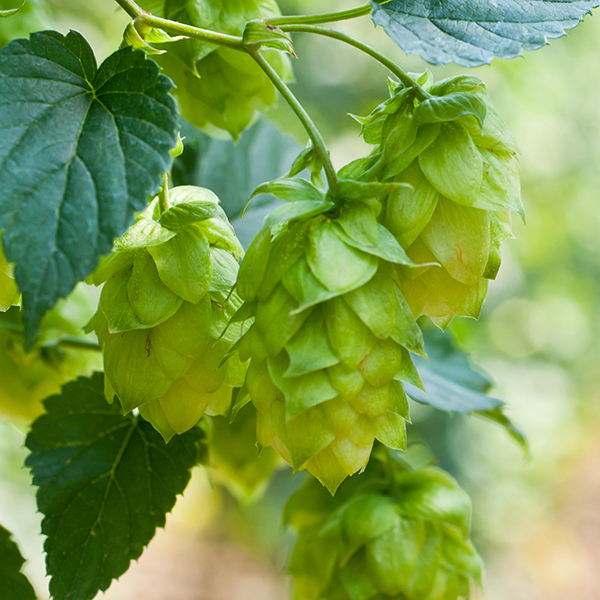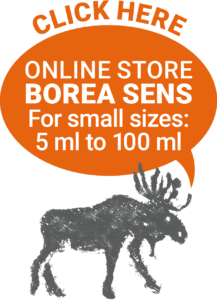HOP ESSENTIAL OIL

Latin Name: Humulus Lupulus var. Cascade
French Name: Houblon
English Name: Hop
Botanical Family Name: Cannabinaceae
Origin: Quebec, Canada
Harvest time: August and September
Distilled Parts: Cones
Organoleptic Characteristics: Clear liquid, clear to pale yellow
Components: Myrcene, α-humulene, (E)-β-Farnesene, β-caryophyllène.
ORIGIN
The Latin name for hops is humulus and comes from the word humus or soil, while lupulus means little wolf. The reason it is named like this may be due to the fact that it exhausts the soil when growing; its appetite resembles that of the wolf. Hops have stems that curl along a trellis or tree and can reach up to ten meters in height. It grows wild in wetlands.
Hops is a dioecious plant, i.e. it produces plants with either male or female flowers. Only the female inflorescences cones are collected. When mature, the glands at the base of the bracts of unpollinated flowers form a yellowish, resinous powder called lupulin, which is rich in aromatic compounds. This is what gives the characteristic bitterness and aroma to beer.
Germany is the largest producer of hops growing nearly forty thousand tons per year, almost 30% of the world’s production. The United States, meanwhile, produces about twenty-eight thousand tons.
In Quebec, hop crops have expanded greatly since the mid-2000s due to the growing interest of craft beer enthusiasts. Some thirty different hops growers are currently active and microbreweries are a multiplying trend to the delight of many Quebeckers. It is indeed now possible to tour the Grand Dukes region by wandering around the different areas of Quebec in search of new flavours: mellow, malted grilled, hoppy or robust. This new industry is very timely, as it contributes to reviving the economy of some small towns by attracting new tourists.
HISTORY
Hildegard of Bingen (1099-1179) discovered the disinfecting properties and the conservative effect of hops which allowed producers to store the beer for longer periods of time. Before his discovery, barley ale was the brew of choice, produced from a mixture of herbs and spices.
Hops is part of the Cannabaceae family (like cannabis). Which explains its sedative effect. To encourage better sleep, insomniacs filled their pillowcases with these dried flowers. It is said that the peasants who harvested the hops had to sing to avoid falling asleep.
The Amerindians made infusions with hop flowers mainly to calm nervousness or insomnia. They also used them to make poultices for pain relief.
BENEFITS
Physical
• Endocrine System: estrogen-like +++, anaphrodisiac.
• Nervous System: sedative, nerve balancing.
• Digestive System: antispasmodic++.
• Circulatory System: antispasmodic.
Uses: Gastritis of nervous origin++, tachycardia, supraventricular arrhythmia+.
Contraindications: Mastosis, hormone-dependent disseminated cancers.1
Recommendation: Essential oils are wonderful for the well-being of humans, animals, insects and plants. There are many books that discuss aromatherapy and you should refer to them for proper and safe use. We also recommend that you consult a professional in aromatherapy who will be able to target the biochemical groups and aromatic molecules of essential oils and thus increase the effectiveness of your care.
Essential oils should be stored in a cool, dry place, protected from light and air.
The information provided on this website is NOT a recommendation of a cure or the treatment of a medical condition or disease.
References
-
https://jardinierparesseux.com/2018/06/13/houblon-herbe-de-lannee
-
2018/#commentshttps://fr.wiktionary.org/wiki/houblon#%C3%89tymologie
-
https://fr.wikipedia.org/wiki/Houblon#Histoire,_usages_du_houblon
-
https://www.passeportsante.net/fr/Solutions/PlantesSupplements/Fiche.aspx?doc=houblon_ps
-
https://www.mapaq.gouv.qc.ca/fr/Productions/agricultureurbaine/trucsconseils/Pages/Cultureduhoublonenville.aspx
-
https://ici.radio-canada.ca/tele/la-semaine-verte/2014-2015/segments/reportage/477/houblon-mecanisation-recolte
-
https://www.florelaurentienne.com/flore/Groupes/Spermatophytes/Angiospermes/Dicotyles/017_Urticacees/01_Humulus/lupulus.htm#Humulus_lupulus_macro
-
https://bieresetplaisirs.com/2016/08/03/levolution-de-lindustrie-houblon-quebec/
-
https://www.journaldequebec.com/2018/08/18/jouer-du-coude-pour-se-demarquer
-
MOERMAN Daniel E., Native American Ethnobotany, timber press, Portland, Oregon, 1998.

